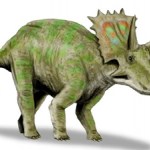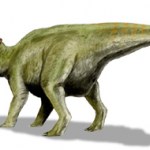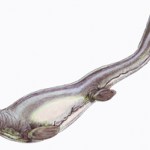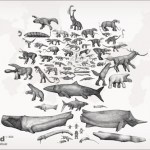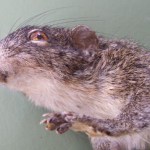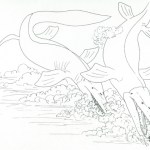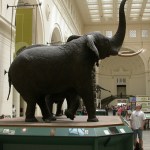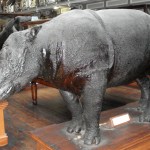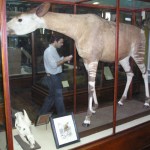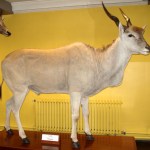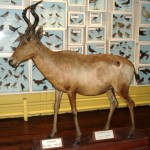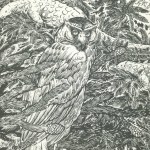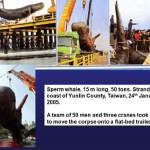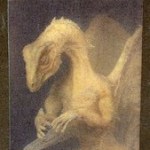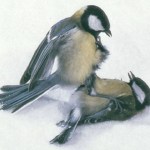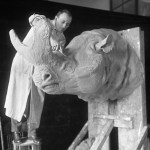
Another obscure ceratopsian from the defunct field guide project: for the back story go here and here.
A distinctive chasmosaurine similar in size to a large rhino (total length approximately 3.5 m), Anchiceratops ornatus was a heavily built species with a particularly short tail and robust limbs [adjacent image from wikipedia. Not bad, but it doesn't depict the rear margin of the frill or epoccipitals correctly]. Barnum Brown first discovered this species in 1912 in the Campanian Dinosaur Park Formation, and named it in 1914. Brown's specimen had long, erect brow horns, leading some to…
Once more, I'm going to start recycling some of those dinosaur texts written for the defunct field guide (for the back-story on that project see the ornithomimosaur article here). This time round, I'll get through some of the ceratopsians [adjacent skull reconstruction from wikipedia, and based on an image by Jaime Headden].
One of the most poorly known ceratopsians, Udanoceratops tschizhovi was a Mongolian species from the Santonian-Campanian Djadokhta Formation. Named in 1992 by Sergei Kurzanov, the holotype consists of an incomplete skull (the frill and everything around the orbital…
Thanks to Monday's article on the unusual African mosasaur Goronyosaurus, I will admit that I was - quite seriously - considering doing a 'mosasaur week', perhaps even a 'weird mosasaur week'. Alas, I have not had the time. However: brand-new in the journals is Johan Lindgren et al.'s article on the skin of a Plotosaurus bennisoni specimen from the Upper Cretaceous Moreno Formation of central California (Lindgren et al. 2009) [adjacent Plotosaurus life restoration from wikipedia]. The specimen was collected by Anthony Fiorillo in 1993 and belongs to an individual that was about 6.4 m long…
Back in June 2008, Nemo Ramjet launched the official website on Snaiad, one of humanity's first off-world colonies. Snaiad's spectacular wildlife has to be seen to be believed: I've been meaning to post a brief introduction to the site for months and here, in 'text-lite' week, is an excellent opportunity. If you like Nemo's work and creatures, or if you're interested in speculative zoology, find a few hours to kill and then go nuts. Here are some random highlights....
These (below) are magnopsids. While most Snaiadi para-tetrapods have arrays of heat receptors arranged around their eyes,…
Cattle are another of those groups of animals that, while they're familiar and while we take them for granted, are really pretty incredible. The size, power and awesome appearance of many wild cattle never fails to amaze me. Markus Bühler (of Bestiarium) has been good enough to share these photos he took of Banteng Bos javanicus and Gaur B. gaurus at Berlin Zoo.
These are Banteng, also known as Tsaine or Tembadau, a wild cattle of southeast Asia, Borneo and Java: the sexual dimorphism is obvious, as is the distinctive white rump patch and 'stockings'. Three subspecies are recognised, of…
Welcome to a week of honest-to-goodness 'text-lite' posts. Yeah, I've made promises about going 'text-lite' before, but I've failed to deliver. This time I'm determined to succeed. We begin with these pretty pictures, provided by Greg Popwell and showing a taxiderm specimen of.. of... well, what? Over to you...
As usual with these sorts of things, apologies if this insults your intelligence. The animal is about 18 cm long.
UPDATE: thanks to all who had a go at identifying the animal. It's obviously a rodent, and obviously a squirrel (long bushy tail, pentadactyl hands, forelimbs and…
One of my favourite mosasaurs is the unusual Goronyosaurus nigeriensis (Swinton, 1930) from the Maastrichtian of Nigeria and Niger. Mosasaurs are Cretaceous marine lizards, (probably) closely related to gila monsters and kin (the monstersaurians) and monitor lizards and kin (the goannasaurians), and well known for evolving gigantic size (>12 m in some taxa), flippers, and paddle-like tails. Goronyosaurus is cool because, with increasing knowledge, it has become weirder and weirder and weirder...
When William Swinton first described and named Goronyosaurus (as Mosasaurus nigeriensis), it…
How do you stuff an elephant? The - ha ha - obvious answer is 'with great difficulty'. As for the actual answer: funnily enough, the preparation and mounting of elephants for museums is quite well recorded. These African bush elephants Loxodonta africana are on display at the Field Museum in Chicago (thanks to Matt Wedel for the photo). Just look at their size, and wonder... how do these dead animals get to look so alive?
All too few people realise that, when you look at a 'stuffed' animal, you're looking at a tanned skin that's been skillfully fitted over a postured mannequin* or replica of…
Yay: day.... err, 4 of Stuffed Megamammal Week (day 1: Khama, day 2; Eland, day 3: Okapi). And now for something completely different... a perissodactyl. Specifically, a rhino and, more specifically still, the weirdest rhino of them all (among extant forms at least): the Sumatran rhino Dicerorhinus sumatrensis. You might have noticed that the claim made earlier in the week that I would go all 'text-lite' for a while hasn't really panned out, so this time I'm going to make a real concerted effort to add nothing new. The good news is that I previously produced a long article on the Sumatran…
Welcome to day 3 of Stuffed Megamammal Week. So far (day 1, day 2) we've looked at bovids. Now for something completely different. Yes, it's that wonderful, charismatic, beautiful African mammal, the Okapi Okapia johnstoni. Again, this specimen is on display at the National Museum of Ireland in Dublin, and sorry the photos aren't that great: the specimen is faded relative to the real thing, and this photo has been further muted by my atrocious camera skills [Gareth Dyke in background].
Okapis are very neat beasts, well known for their velvety, dark brown to purplish, striped coat. Their fur…
Welcome to day 2 of Stuffed Megamammal Week! [day 1 here]. This time round, it's an eland. The individual's slim, pointed ears and prominent forehead tuft show that it's a Common eland Taurotragus oryx rather than a Giant or Derby's eland T. derbianus. Elands are the largest antelopes, weighing up to a ton.
I love elands: like certain other artiodactyls, they have inherited such things as distinctive colour patches, hair tufts, manes and dewlaps, but have developed them to an extreme, such that they are now super-endowed, flamboyant, extreme members of their group. In a fine, fully mature…
I said the other day that I was going to have go all 'text lite' for a while. Here is my solution: a series of short posts, one per day, each of which features a different stuffed megamammal. Yes, welcome to day 1 of stuffed megamammal week. All of the stuffed megamammals you're going to see were photographed in the excellent collection at the National Museum of Ireland, Dublin. So here we go.
This remarkable creature is a Hartebeest Alcelaphus buselaphus, and, specifically, it's a female hartebeest belonging to the subspecies known as the Khama, Cape or Red hartebeest A. b. caama. Like so…
I've been seriously thinking about letting Tet Zoo lay fallow for a while, as I have a lot on right now and it's a horrendous distraction that I really shouldn't spend time on. Producing long articles like the one on the Sakhalin Island carcass are very satisfying, but they soak up a lot of time. The day job keeps me busy, well, all day, and academic and editorial commitments keep me busy most nights - and this is on top of having a new baby in the house. Today I made a special effort to just go out on my own and waste time looking at stuff in shops, purely because I feel immense pressure to…
Here are assorted relevant things that happened in March: ahh, what a month. First of all, another sea monster. It's the famous fishy-crustaceany monster thing at Plymouth Hoe Barbican...
Here's a dead Mute swan Cygnus olor I found among all the rubbish during the Chessel Bay clean-up. I have its head.
And here's a dead female Bullfinch Pyrrhula pyrrhula a friend gave me. Why do finches so often have those big callouses on their feet? Is this the same thing as the bumblefoot infection that sometimes affects captive birds? Bullfinches are carduelines, most closely related to hawfinches and…
.... but the whale had been sitting around, decomposing, for several days...
Pity the person who came back to collect their parked scooter at the end of the day...
It has often been proposed that large reptiles, such as monitor lizards and crocodiles, might have provided the origin for the dragon myths of the world. There might be some truth to this, but the possibility that rather more spectacular reptiles might have played a contributing role is rather more plausible. Confirmation for this hypothesis comes from Hypoblanpied whartoni, described in 2003 from the Pleistocene of France (Freeman 2003).
Freeman (2003) identified seven characters shared by the new taxon and Kuehneosauridae: that's really interesting, because Hall (1991) had proposed much…
I used to receive random unsolicited emails from an individual who strongly promoted the idea that birds could not not not not be dinosaurs, that the entire dinosaur family tree was screwed up beyond belief, that 'dinosaurs' had evolved from random assorted diverse archosaurs, that cladistics was rubbish, and that all mainstream palaeontologists were idiots.
For some reason, the study of dinosaurs attracts people with strong 'fringe' beliefs: this must be a by-product of popularity, as you don't get this with temnospondyls, fossil ostriches, Eocene primates, corals or sea jellies (at least…
Every now and again a carcass of a large marine animal washes up on a beach somewhere: local people and journalists identify it as a monster, and all hell breaks loose. Inevitably, the carcass turns out to be a decomposing whale or shark. Typically, it now becomes known that a person who arrived at the scene early on stated exactly this, but, because their conclusion was rather boring, it was ignored - or mentioned only in the very last paragraph of a newspaper article. We've looked at this sort of thing before, many times, on Tet Zoo: see the links below.
Last year cryptozoological…
I may as well finish what I started. Inspired by the two recent brontothere articles, Dan Varner and Mike P. Taylor were kind enough to supply the pictures you see here. Both feature Megacerops specimens displayed at the American Museum of Natural History in New York.
This classic photo shows Erwin S. Christman (1885-1921) working on the life-sized Megacerops head that he and William K. Gregory created for what's now the Lila Acheson Wallace Wing of Mammals and Their Extinct Relatives at the AMNH [we looked briefly at Christman's work on theropod dinosaurs back here]. At the time (c. 1911),…
Yesterday's brief look at brontotheres was such a rip-roaring success I thought I'd do a little bit more on them (on members of Brontotheriidae that is, not on rip-roaring successes). No time for a proper article: all I've done here is to take screen-shots of various powerpoint slides (from a perissodactyl lecture I give), and throw in a few words where appropriate.
To begin with, we mostly know of brontotheres thanks to the gigantic, Late Eocene North American taxon Megacerops Leidy, 1870, now thought to include both Brontotherium Marsh, 1873 and Brontops Marsh, 1887 (the slides shown here…
